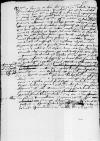List #1742
[Ioannes DANTISCUS] do [Jan CHOJEŃSKI]Graudenz (Grudziądz), 1537-10-05
Rękopiśmienne podstawy źródłowe:
Pomocnicze podstawy źródłowe:
Publikacje:
| ||||||||
Tekst + aparat krytyczny + komentarz Zwykły tekst Tekst + komentarz Tekst + aparat krytyczny
Reverendissime in Christo Pater et Domine, Domine mi colendissime. Salutem et mei commendationem plurimam.
Paulo ante, hoc est prima die huius mensis, hinc Dominationi Vestrae Reverendissimae de rebus meis copiose cf.
Ex
[1 ] The seal of Royal Prussia was used to seal important documents and deeds issued by the Prussian Council and the Prussian general assemblies. Until 1613, the former land seal of the governor of Prussia (this office was in existence in the years 1456-80) was used as the seal of Royal Prussia. The seal was kept at the Elbląg town hall, in the care of the local town council. It was delivered to the assemblies by the Elbląg delegates, and sealing of documents was performed in their quarters. If the Elbląg delegation did not show up at an assembly, the seal of one of the councilors was used, confirmed by a handwritten signature. (cf. cf. GERLACH p. 114-118, 130-131 ⌊Gerlach, p. 114-118, 130-131cf. GERLACH p. 114-118, 130-131 ⌋. Obviously, such confirmation was insufficient for the matter discussed in this letter
[2 ] The matter that Nipszyc was to report to the king and Chojeński concerned the summoning of Gdańsk castellan Achatius Cema by the Brandenburg elector to secret talks in
Berlin. The Prussian Council’s letters to Chojeński and Sigismund I on
this matter, which Nipszyc was to take, were edited by Dantiscus. Both rough copies – Dantiscus’ autographs – are kept at BCz, 244, p.270 (cf.
